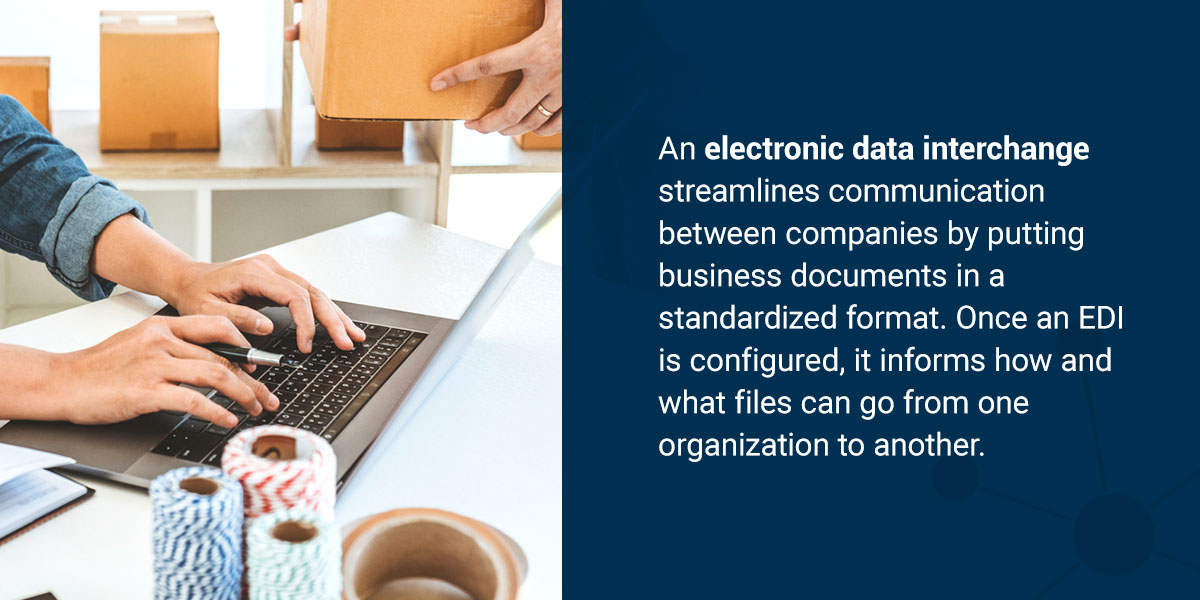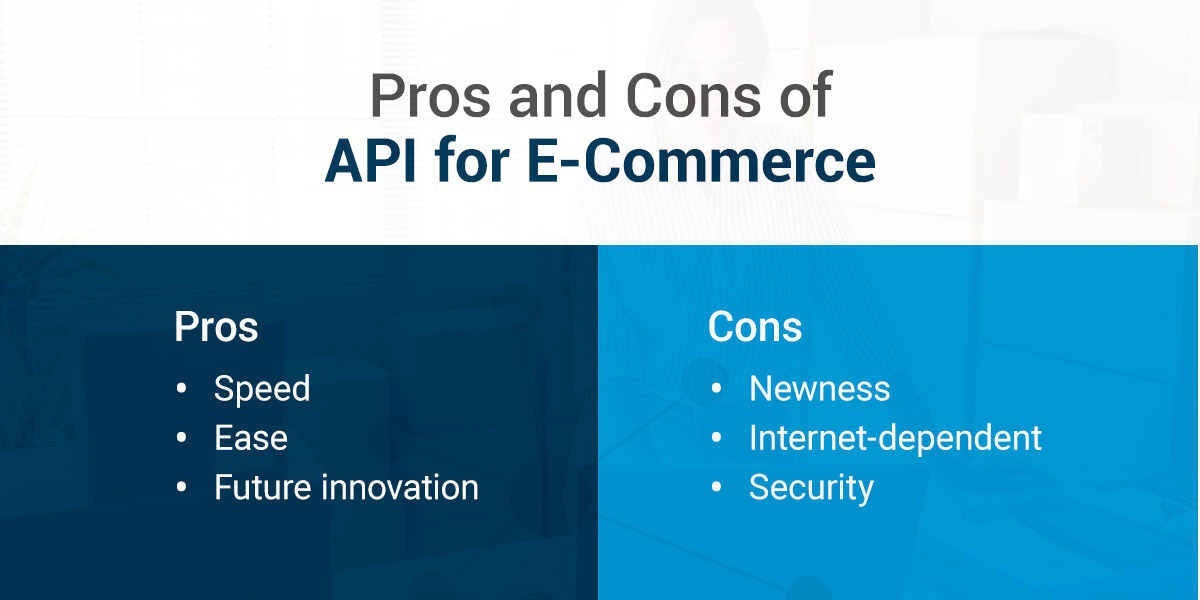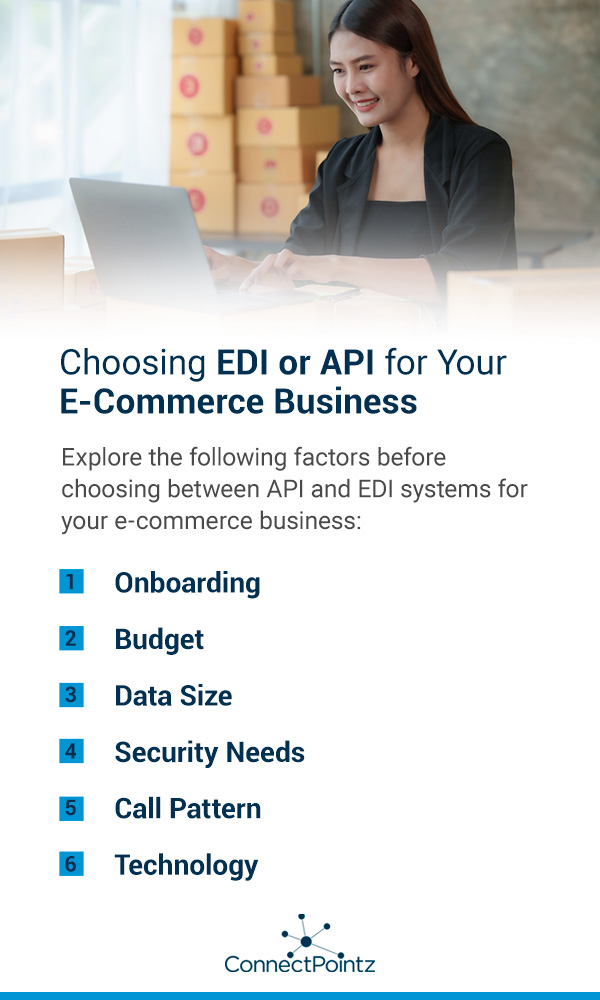
E-commerce businesses need reliable and efficient methods of connecting with their suppliers. Electronic data interchanges (EDIs) have been around for decades, but newer systems, such as application programming interfaces (APIs), are gaining traction.
While both EDIs and APIs can be useful in transmitting important data between business partners, they have unique features and different strengths and weaknesses you should consider before choosing one or the other.
Understanding APIs
An application programming interface refers to a software intermediary that functions as a link between two applications. API systems allow you to communicate back and forth across different organizations using the internet. They are a simplified version of computer-to-computer interactions.
As businesses and technologies evolve, the need for reliable and immediate interactions with internet-enabled tools continues to grow. API systems aim to expand the ways we can utilize our devices. Whether you are buying a product online or booking a car on an application, many people use APIs daily.
One of the key advantages of API systems is their real-time capabilities.
How Do APIs Work?
Put simply, an API operates similarly to a waiter at a restaurant. Customers do not go directly to the kitchen and request their meals. Instead, they communicate through the waiter, who then relays their requests to the kitchen. Once the cooks finish making the food in the kitchen, the waiter, like the API, brings the completed order back to the customer.
The API operates as a liaison carrying messages between an application and a web server. APIs are gaining popularity thanks to their efficiency and real-time data retrieval capabilities.
Understanding EDIs
Electronic data interchanges are a slightly different type of system. They take data from an internal system and translate it into a certain file format that a partner's internal system can read. In more basic terms, an EDI is a system that makes data easily understandable for another system by setting a standardized format for transferring data.
Some of the messaging protocol file types that an EDI might translate information into include:
- HTTPS, or hypertext transfer protocol secure
- SFTP, or secure file transfer protocol
- AS2, or applicability statement 2
- SOAP, or simple object access protocol

How Do EDIs Work?
An electronic data interchange streamlines communication between companies by putting business documents in a standardized format. Once an EDI is configured, it informs how and what files can go from one organization to another. It functions as a form of quality control over documents and helps streamline the communication of data between the systems of different trading partners.
The two main types of EDI transmission include:
- Value-added network: A third-party network, also called an EDI network services provider, manages the data transfer between organizations.
- Point-to-point: Also called direct connections, this type of transmission operates via two different systems that use the internet to connect to each other.
Key Differences Between EDI and API
EDI (Electronic Data Interchange) and API (Application Programming Interface) are both technologies used to facilitate data exchange between systems, but they differ significantly in their structure, flexibility, and application in modern business operations. While EDIs and APIs share some similarities, the two have a few key distinctions that are important to keep in mind for businesses considering one or the other.
1. History
EDIs have been around for many decades. In fact, this type of system was first put into action by the supply chain used for aircraft assembly. As time went on, new industries began using EDIs to communicate with their trading partners.
EDIs are still very popular, though there has been a major shift toward APIs in recent years, as organizations are depending on web applications more and more. APIs are newer but gaining popularity and quickly replacing EDIs for many businesses.
2. Transactions
Electronic data interchanges connect two alike systems for exchanging information and data. An EDI transaction is representative of the sender's system at a certain time.
Application programming interfaces make it possible for different types of systems to communicate back and forth.
3. Flexibility
Because EDIs operate with standardized protocols, they are significantly less flexible than APIs. An EDI system requires all participants to align with a specific data structure.
In comparison, no two APIs are the same. They allow for much more flexibility, as they can meet specific industry requirements that EDIs cannot.
EDI vs. API for E-Commerce
Explore some of the key comparisons between EDI and API for e-commerce applications:
EDI for E-Commerce
Suppliers often utilize electronic data interchanges to communicate their wholesale order data with their distributors and retailers. EDIs involve transmitting documents between partners more so than completing the buying and selling of orders.
The process involves a great deal of time and energy from everyone involved, so it is often more suitable for e-commerce businesses that have high sales volumes. By automating information sharing across partners, EDI systems can improve data accuracy and reduce paper documentation. They also help streamline transaction flow and improve data accuracy.
API for E-Commerce
E-commerce systems often utilize application programming interfaces to connect with suppliers and sellers for direct-to-consumer orders. API systems can integrate with third-party applications used in e-commerce, such as the following:
- Inventory management software
- Payment processors
- Third-party sellers
- Online shopping carts
- Web-based advertising campaigns
- Printing shipping labels
E-commerce APIs can save your business valuable time and energy by providing direct access to your most important data.
Businesses can also use API systems for order data across all their systems. Their straightforward integration makes it possible to reduce errors associated with manual data entry. No matter the size and scale of an e-commerce business, implementing APIs can be beneficial in expanding your operation.

Pros and Cons of API for E-Commerce
The following are some of the main pros and cons of utilizing API for an e-commerce business:
Pros
API systems have many advantages for businesses working within a supply chain. The most notable pros of application programming interfaces include:
- Speed: APIs can quickly collect data because they are not reliant on manual document uploading processes or pickup requests. They utilize Internet of Things tech to create connections between systems that automatically update data as it becomes readily available. APIs can do the job of an EDI in significantly less time. In some cases, a process that would require hours for an EDI can take just minutes with an API system. Real-time data accessibility with an API allows users to tackle issues sooner and make more precise projections for the future.
- Ease: An API system streamlines data transmissions and collection while foregoing the need for customization. Unlike an EDI, the users do not need to have the same versions to communicate back and forth. APIs easily allow for different existing systems to connect.
- Future innovation: Another advantage of API systems is their ability to make integration easier. As technologies advance and evolve, APIs can better support them than an EDI. An API offers greater visibility into the entire supply chain.
Cons
In addition to all the positive aspects of API systems, they have a few shortcomings, including:
- Newness: Application programming interfaces are a newer technology, which means that not all industries have adopted these systems yet. Because it is newer, many users are still not on board with transitioning from an EDI, which may impact your decision to switch over to an API system.
- Internet-dependent: Another downside of application programming interfaces is their reliance on an internet connection. Despite the advancements in the internet and its presence nearly everywhere, it is not a foolproof system, and connectivity problems can occur anywhere. An API is dependent on a steady internet connection — if the internet is down, an API system's functions are also down.
- Security: Because they rely on the internet, APIs are also less secure than EDIs. They depend on web software that is more vulnerable to data breaches and cyberattacks. All systems are interconnected with an API, so a serious data breach could impact every facet of the system and create major issues.
Pros and Cons of EDI for E-Commerce
Explore the pros and cons of opting for EDI for an e-commerce operation:
Pros
Using an electronic data interchange can have a few key advantages for your operation, including the following:
- Security: EDIs are highly secure and have robust privacy settings. The systems establish a connection between only two authorized parties. After setup is complete, the information both parties send and receive is protected against unauthorized access. Companies and organizations that share confidential information may favor EDI because of its protection against cyberattacks and hacking.
- Accessibility: EDIs are very popular and have become a standard across many industries. Because of its prevalence, finding partners with existing EDI systems is often easy. Accessibility is one of the greatest advantages of EDIs. However, this may not be true in the future as APIs gain more traction.
- Faster than manual processing: EDI systems are easy to use and streamline manual document processing. Users can abandon old and inefficient practices using technology for faster data collection and communication. EDIs can save your operation hours of manual labor while reducing costs. Thanks to their popularity, finding a specialist to help users understand how to put EDIs to work is also relatively easy.
Cons
Despite their prevalence and ease of use, electronic data interchanges have some downsides too. The following are some of the major cons associated with these systems:
- Costs: EDIs are an investment. Implementation can take months to complete because you must train users and coordinate systems. Reaching functionality can be a costly process, and you may need to reach out to an EDI specialist for additional assistance, which can come with separate expenses.
- Various versions: EDI systems have to match across both partners. Users must ensure all partners have the same version. If the versions do not match, then one must upgrade before the integration process occurs. Getting both partners on the same version can take up valuable time and money.
- Integration: Because EDI systems create a link between only two partners, it can be more complicated if you want to include another party. In this case, users have to begin again to ensure all parties have a compatible version. All partners need to abide by the same transmission standards, and it often requires starting the process from the beginning.
- Age: EDIs are on track to become an outdated technology in the years to come. These systems are not compatible with many advancing technologies, like blockchains. The antiquated aspects of electronic data interchanges make it difficult for users to evolve.

Choosing EDI or API for Your E-Commerce Business
Both application programming interfaces and electronic data interchanges can be handy for e-commerce operations. However, they can serve very different purposes and have unique pros and cons.
Explore the following factors before choosing between API and EDI systems for your e-commerce business:
1. Onboarding
Consider the ease of onboarding for both EDIs and APIs. EDI systems support easy onboarding for new partners as long as they are already connected to the provider's network. API systems, however, require the data layer to be created for onboarding new partners.
2. Budget
Your budget is a major factor to consider when choosing between API and EDI systems.
Implementing EDI systems for your e-commerce business often costs more than introducing APIs. The process takes longer and often requires training that can contribute to greater overall expenses.
3. Data Size
Another important consideration is the amount of data your e-commerce operation uses. EDI systems are typically better suited for managing mass data.
API systems are not intended to handle mass amounts of data. They may even have data rate limits.
4. Security Needs
Electronic data interchanges are more secure than API systems. EDIs can adhere to and fulfill strict compliance regulations.
While some APIs provide better security than others, they do not always adhere to compliance regulations and may not provide the protections needed against cyberattacks and hackers.
5. Call Pattern
When deciding between API and EDI systems, call pattern is an important factor to keep in mind.
Application programming interfaces use a synchronous call pattern and support real-time exchanges. EDIs use an asynchronous call pattern intended for batch exchanges.
6. Technology
APIs and EDIs require different technologies to support their operations.
API systems are typically cloud-based, and operation is dependent on an internet connection. EDIs are often reliant on physical, on-premise servers. Both types of technology have different advantages and limitations.
Contact ConnectPointz to Learn More About EDI and API Integrations
Are you looking for integration solutions for your business? Turn to ConnectPointz. We offer custom-integrated solutions to help your business connect and automate its systems.
With more than 35 years of industry and technology experience, we can help you establish automation from processing orders to shipping them. Our platform supports seamless integration with trading partners, warehouse management systems and more. We have both API and EDI integration solutions, and our team can help you find the right option for your unique requirements.
Contact ConnectPointz to learn more about our integration solutions and explore our pricing page today.










































